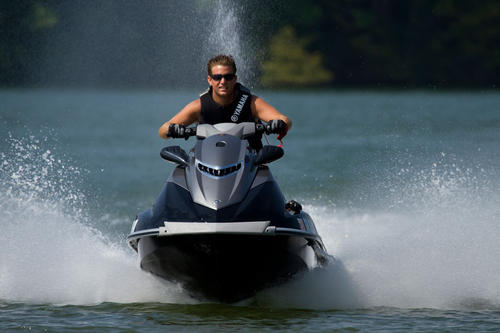2011 Yamaha VXS Review
Thrilling performance, cheap price. What's not to love?
The idea seems so simple, you wonder why no one ever did it before — take a powerful, high-horsepower engine, lose the pricey, gas-hungry supercharger, and toss it in a lightweight, agile hull. Follow that formula and you just might create a boat that runs with the market’s fastest, while chopping literally thousands off the price tag.
That’s precisely what Yamaha has done with the VXS…and the result is quite possibly the best bang for the buck the industry has ever seen.
Do The Math…
Like its sibling the VXR, the VXS is all about horsepower-to-weight ratio. The horsepower comes courtesy of the industry’s largest-displacement engine, an 1,812cc four-cylinder four-stroke that, in this guise, doesn’t require a supercharger to do its dirty work. That means it will use less fuel, require less maintenance, and take less out of your pocket on the showroom floor.
What it doesn’t mean, however, is that you’ll miss the supercharger’s added punch. Tucked within the lightweight confines of the existing VX hull platform, this engine pushes the VXS to speeds in excess of 67 mph, and 0-30 times of about 1.8 seconds. Those are premium flagship numbers, not what you’d expect out of a craft that retails for only $10,899.
 With 180 horsepower on tap you’ll have no trouble towing a skier behind the VXS.
With 180 horsepower on tap you’ll have no trouble towing a skier behind the VXS.Why the VX, previously considered Yamaha’s most entry-level boats? For starters, they’re begging for the opportunity. VX hulls have always proven aggressive and predictable. The added power now just shows how ready they were for the spotlight. Yes, the VX received a few subtle tweaks last year to get ready — the pump inlet was modified and the deck received a few tweaks. Fine-tuning the craft’s sponson placement further enhanced its ride. One of the big changes, however, had to be the switch to NanoXCel for the hull material. Introduced several years back as an alternative to the conventional Sheet Molding Compound (SMC), NanoXCel increased strength while slashing weight. Just check those specs; the VXS tips the scales at a mere 721 pounds.
Then Hang on Tight
Given that the engine is estimated at 180 hp, that equates to better-than-average power pushing around a lighter-than-average boat.
On the water, it feels very much like you’d expect. Make no mistake, this is a hot rod. It doesn’t jump, but almost vaults when you pin the throttle, tearing across the water with a single purpose. Still, those runs are trademark Yamaha. I felt confident and in control and not worried that the ear-to-ear grin would be wiped off my face by an ill-timed wake.
 The VXS has a definite learning curve. If you want to get the most out of this craft it’s going to take a little practice.
The VXS has a definite learning curve. If you want to get the most out of this craft it’s going to take a little practice.As I found on the VXR, however, cornering requires a good deal of rider input to get just right. When I got my weight in the right position, the boat carved so hard I literally strained the first few times to stay aboard. It’s absolutely thrilling, like getting your hands on some type of race boat you’d normally have no business driving. While you’re mastering its learning curve, however, be prepared for a few moments of panic if the hull starts to drift in one of those high-speed corners. Different riders will experience different results, but for me it all came down to weight placement. I found I had to keep more weight towards the stern to slice and dice as intended. I also found success chopping the throttle slightly heading into a turn to drop the bow, before cranking on the power and blasting through.
And again, that’s part of the boat’s appeal. You don’t just sit on it and pin the throttle, you learn to exploit its strengths.
Little Frills
Don’t expect bountiful extras. The goal of the VXS is to celebrate the absolute basics that make a PWC so fun to ride. While you do get the remote security transmitter (that can also activate a low RPM mode), you can’t tilt the handlebars, or play with electronic throttle goodies, or even mess with trim.
In short, Yamaha gives you a set of handlebars and a throttle, and a seat design more tailored to three-up riding or towing, and turns you loose.
Which, in this age of bountiful extras, is actually kind of fun…
| 2010 Yamaha VXR Specs | |
| Length | 126.8 inches |
| Beam | 46.1 inches |
| Curb Weight | 721 lbs |
| Engine | Four-cylinder DOHC EFI |
| Displacement | 1,812 cc |
| Bore and Stroke | 86mm x 78mm |
| Compression Ratio | 11.0:1 |
| Rated Horsepower | 180 (Estimated) |
| Fuel Capacity | 15.9 gal. |
| Combined Stowage Capacity | 15.1 gal. |
| Colors | Eclipse Black |
| Price | $10,899.00 |
Related Reading
2011 Yamaha VXS/VXR Preview
2011 Yamaha VXR Review
2010 Yamaha VX Deluxe Review
2010 Yamaha VX Sport Review
2010 Yamaha FZS Review
Get PersonalWatercraft.com in your Inbox!
Like PersonalWatercraft.com on Facebook
Comments
Most Popular

2025 Yamaha JetBlaster PRO 2-Up Review

2024 Kawasaki Jet Ski STX 160X Review

Remembering the Sea-Doo XP

Whatever Happened to the Wetbike?

2025 Yamaha JetBlaster Review














 Your Privacy Choices
Your Privacy Choices